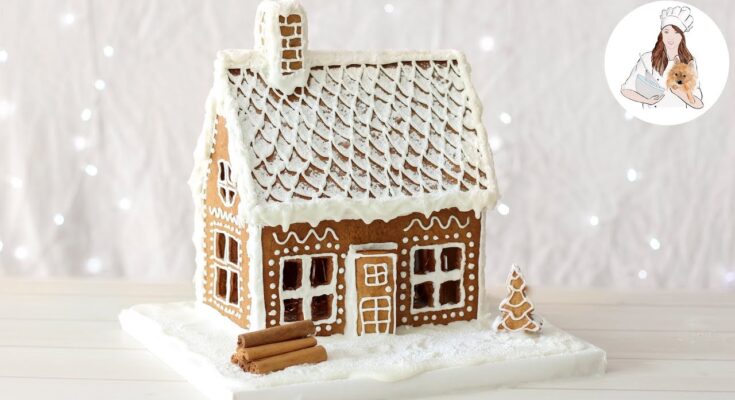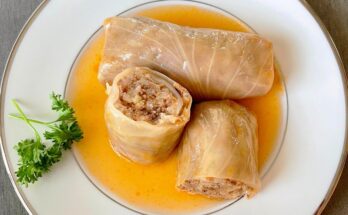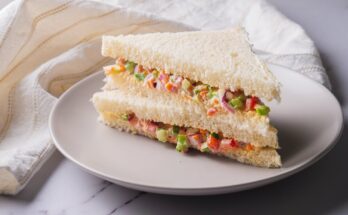Gingerbread Recipe: Nothing screams the holidays quite like the warm, spicy aroma of freshly baked gingerbread wafting through your home. Gingerbread, a classic festive treat, is as versatile as it is delicious, lending itself to cookies, houses, and other creative shapes. Want to bring some cheer to your holiday season? Let’s dive into the ultimate step-by-step guide to crafting perfect gingerbread cookies from scratch!
Ingredients for Gingerbread
To start your gingerbread-making journey, it’s crucial to gather all the necessary ingredients. Here’s a breakdown:
1. Dry Ingredients
- Flour: 3 ½ cups of all-purpose flour are standard for structure.
- Spices: Ground ginger (1 tablespoon), cinnamon (1 teaspoon), cloves (¼ teaspoon), and nutmeg (¼ teaspoon) provide the warm, aromatic flavor.
- Baking soda: 1 teaspoon to ensure a slight rise.
2. Wet Ingredients
- Butter: ¾ cup (softened) for richness.
- Brown sugar: ¾ cup for sweetness and moisture.
- Molasses: ½ cup for that signature deep flavor.
- Egg: 1 large egg, which binds everything together.
3. Optional Add-ons
Feel free to get creative with decorations like icing, sprinkles, or edible glitter. These extras make gingerbread even more festive.
Essential Tools and Equipment
Having the right tools on hand makes the process smooth and enjoyable:
1. Baking Tools Needed
- Large mixing bowls (one for dry and one for wet ingredients)
- Rolling pin for flattening the dough
- Cookie cutters in festive shapes like stars, trees, and gingerbread people
2. Preparing Your Workspace
Before diving in, ensure your counter is clean and lightly dusted with flour to prevent sticking.
3. Optional Tools
- Piping bags for icing precision
- Cooling racks for even cooling after baking
Step-by-Step Instructions
Let’s get baking! Follow these detailed steps for perfect gingerbread every time:
1. Preparing the Dough
Start by whisking together the dry ingredients (flour, spices, and baking soda) in a bowl. In another bowl, cream the butter and sugar until fluffy. Gradually add the molasses and egg, mixing until smooth. Slowly combine the dry ingredients into the wet mixture, forming a dough. Wrap it in plastic wrap and chill for at least 1 hour.
2. Rolling and Cutting
Once the dough is firm, roll it out on a floured surface to about ¼ inch thickness. Use cookie cutters to shape your gingerbread into festive designs. Place the cutouts on a baking sheet lined with parchment paper.
3. Baking the Gingerbread
Bake in a preheated oven at 350°F (175°C) for 8-10 minutes. Keep an eye on them—they should be firm but not overly browned. Allow them to cool completely before decorating.
Decorating Your Gingerbread
1. Making Royal Icing
Combine 2 cups of powdered sugar, 1 egg white, and 1 teaspoon of lemon juice. Mix until smooth. Adjust the consistency with water or more sugar as needed.
2. Decorating Techniques
Transfer the icing to a piping bag and outline your cookies. Add sprinkles or candies while the icing is wet to secure them.
Tips for Perfect Gingerbread
- Preventing Overbaking: Remove cookies just as the edges firm up for softer results.
- Dough Consistency: Too sticky? Add more flour. Too dry? Mix in a bit of water.
- Storing: Store in an airtight container at room temperature for up to a week.
Variations of Gingerbread
Gingerbread is a versatile treat, and you can tweak the recipe to fit your preferences or dietary needs. Here are a few popular variations:
1. Soft and Chewy Gingerbread Cookies
If you prefer your gingerbread cookies to be soft and chewy, reduce the baking time slightly and add a tablespoon of honey or maple syrup to the wet ingredients. This keeps the cookies moist and adds a subtle sweetness.
2. Gingerbread Houses
To make a sturdy gingerbread house, use less leavening (baking soda) to prevent the dough from rising too much and becoming too soft. Roll the dough slightly thicker and bake for a few extra minutes for durability. Don’t forget royal icing as the “glue” to assemble the house!
3. Vegan and Gluten-Free Options
For a vegan version, substitute butter with vegan margarine and the egg with a flaxseed mixture (1 tablespoon ground flaxseed + 2.5 tablespoons water). For gluten-free gingerbread, use a gluten-free all-purpose flour blend and ensure your baking soda and other ingredients are gluten-free.
Common Mistakes and How to Avoid Them
Gingerbread baking can be tricky if you’re not familiar with the process. Here’s how to steer clear of common pitfalls:
1. Overworking the Dough
Overmixing can activate the gluten in flour, leading to tough cookies. Mix the dough just until the ingredients are combined.
2. Incorrect Baking Times
Keep a close watch on your cookies. Slightly underbaking is better for a softer texture, while overbaking will make them crunchy.
3. Decorating Issues
If your icing is too runny, it won’t hold its shape. Always test the consistency before starting. Add more powdered sugar if necessary.
Serving and Presentation
Presentation adds to the festive charm of gingerbread, making it a delightful centerpiece or gift.
1. Ideas for Display
Arrange your cookies on a decorative tray or tiered stand. You can also package them in clear bags tied with festive ribbons to give as gifts.
2. Pairing Suggestions
Pair your gingerbread cookies with a steaming cup of hot cocoa, mulled cider, or spiced tea. The flavors complement each other beautifully.
Health Benefits of Gingerbread Ingredients
Gingerbread isn’t just tasty—it also has surprising health benefits thanks to its key ingredients.
1. The Benefits of Ginger and Cinnamon
- Ginger is known for its anti-inflammatory properties and can aid digestion.
- Cinnamon has antioxidants and helps regulate blood sugar levels.
2. Nutritional Facts
Gingerbread cookies are a good source of energy and contain small amounts of vitamins and minerals, such as iron from molasses.
FAQs about Gingerbread Recipe
1. What is gingerbread made of?
Gingerbread typically includes a mix of flour, sugar, butter, eggs, and spices like ginger, cinnamon, and cloves. Some recipes also incorporate molasses or honey for added sweetness and depth of flavor.
2. What is the key to making soft gingerbread?
To achieve soft gingerbread, avoid overmixing the dough and bake it just until set. Adding molasses or brown sugar can help retain moisture, giving the gingerbread a soft texture.
3. Can I make gingerbread without molasses?
Yes, you can substitute molasses with honey, maple syrup, or dark corn syrup. These alternatives will slightly alter the flavor but still result in delicious gingerbread.
4. How do I store gingerbread to keep it fresh?
Store gingerbread in an airtight container at room temperature for up to a week. For longer storage, you can freeze the gingerbread for up to three months.
5. Can I decorate gingerbread cookies?
Absolutely! Use royal icing or a mix of powdered sugar and milk to create intricate designs. Add sprinkles or edible decorations to make your gingerbread cookies festive.
6. What’s the difference between gingerbread and ginger cake?
Gingerbread is typically firmer and shaped into cookies or houses, while ginger cake is softer and more cake-like, often served as slices.
7. Why does my gingerbread dough crack?
Cracking can occur if the dough is too dry or cold. Let the dough rest at room temperature for a few minutes before rolling, and ensure it’s well-kneaded.
8. Can I make gingerbread vegan?
Yes! Replace butter with vegan margarine, eggs with flaxseed or chia seed mixtures, and use plant-based milk alternatives for a vegan-friendly gingerbread recipe.
Conclusion
Baking gingerbread cookies is a fun, festive tradition that brings the family together and fills your home with the heartwarming scents of the holiday season. Whether you’re crafting gingerbread people, houses, or unique designs, the possibilities are endless. So, grab your apron, unleash your creativity, and enjoy the process!



